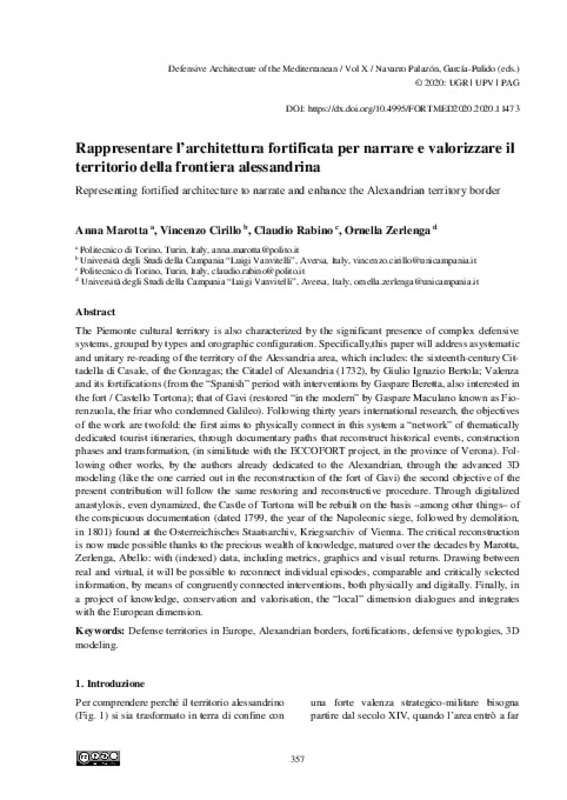JavaScript is disabled for your browser. Some features of this site may not work without it.
Buscar en RiuNet
Listar
Mi cuenta
Estadísticas
Ayuda RiuNet
Admin. UPV
Rappresentare l’architettura fortificata per narrare e valorizzare il territorio della frontiera alessandrina
Mostrar el registro sencillo del ítem
Ficheros en el ítem
| dc.contributor.author | Marotta, Anna
|
es_ES |
| dc.contributor.author | Cirillo, Vincenzo
|
es_ES |
| dc.contributor.author | Rabino, Claudio
|
es_ES |
| dc.contributor.author | Zerlenga, Ornella
|
es_ES |
| dc.coverage.spatial | east=8.611679600000002; north=44.90727270000001; name=Via Savona, 38, 15121 Alessandria AL, Itàlia | es_ES |
| dc.date.accessioned | 2020-07-20T05:57:41Z | |
| dc.date.available | 2020-07-20T05:57:41Z | |
| dc.date.issued | 2020-05-15 | |
| dc.identifier.isbn | 9788490488560 | |
| dc.identifier.uri | http://hdl.handle.net/10251/148294 | |
| dc.description.abstract | [EN] The Piemonte cultural territory is also characterized by the significant presence of complex defensive systems, grouped by types and orographic configuration. Specifically,this paper will address asystematic and unitary re-reading of the territory of the Alessandria area, which includes: the sixteenth-century Cittadella di Casale, of the Gonzagas; the Citadel of Alexandria (1732), by Giulio Ignazio Bertola; Valenza and its fortifications (from the “Spanish” period with interventions by Gaspare Beretta, also interested in the fort / Castello Tortona); that of Gavi (restored “in the modern” by Gaspare Maculano known as Fiorenzuola, the friar who condemned Galileo). Following thirty years international research, the objectives of the work are twofold: the first aims to physically connect in this system a “network” of thematically dedicated tourist itineraries, through documentary paths that reconstruct historical events, construction phases and transformation, (in similitude with the ECCOFORT project, in the province of Verona). Following other works, by the authors already dedicated to the Alexandrian, through the advanced 3D modeling (like the one carried out in the reconstruction of the fort of Gavi) the second objective of the present contribution will follow the same restoring and reconstructive procedure. Through digitalized anastylosis, even dynamized, the Castle of Tortona will be rebuilt on the basis –among other things– of the conspicuous documentation (dated 1799, the year of the Napoleonic siege, followed by demolition, in 1801) found at the Osterreichisches Staatsarchiv, Kriegsarchiv of Vienna. The critical reconstruction is now made possible thanks to the precious wealth of knowledge, matured over the decades by Marotta, Zerlenga, Abello: with (indexed) data, including metrics, graphics and visual returns. Drawing between real and virtual, it will be possible to reconnect individual episodes, comparable and critically selected information, by means of congruently connected interventions, both physically and digitally. Finally, in a project of knowledge, conservation and valorisation, the “local” dimension dialogues and integrates with the European dimension. | es_ES |
| dc.language | Italiano | es_ES |
| dc.publisher | Editorial Universitat Politècnica de València | es_ES |
| dc.rights | Reconocimiento - No comercial - Sin obra derivada (by-nc-nd) | es_ES |
| dc.subject | Fortifications | es_ES |
| dc.subject | Mediterranean | es_ES |
| dc.subject | Modern age | es_ES |
| dc.subject | Built Heritage | es_ES |
| dc.subject | Defense territories in Europe | es_ES |
| dc.subject | Alexandrian borders | es_ES |
| dc.subject | Defensive typologies | es_ES |
| dc.subject | 3D modeling | es_ES |
| dc.title | Rappresentare l’architettura fortificata per narrare e valorizzare il territorio della frontiera alessandrina | es_ES |
| dc.title.alternative | Representing fortified architecture to narrate and enhance the Alexandrian territory border | es_ES |
| dc.type | Capítulo de libro | es_ES |
| dc.type | Comunicación en congreso | es_ES |
| dc.identifier.doi | 10.4995/FORTMED2020.2020.11473 | |
| dc.rights.accessRights | Abierto | es_ES |
| dc.description.bibliographicCitation | Marotta, A.; Cirillo, V.; Rabino, C.; Zerlenga, O. (2020). Rappresentare l’architettura fortificata per narrare e valorizzare il territorio della frontiera alessandrina. Editorial Universitat Politècnica de València. 357-364. https://doi.org/10.4995/FORTMED2020.2020.11473 | es_ES |
| dc.description.accrualMethod | OCS | es_ES |
| dc.relation.conferencename | FORTMED2020 - Defensive Architecture of the Mediterranean | es_ES |
| dc.relation.conferencedate | Octubre 01-03,2020 | es_ES |
| dc.relation.conferenceplace | Granada, Spain | es_ES |
| dc.relation.publisherversion | http://ocs.editorial.upv.es/index.php/FORTMED/FORTMED2020/paper/view/11473 | es_ES |
| dc.description.upvformatpinicio | 357 | es_ES |
| dc.description.upvformatpfin | 364 | es_ES |
| dc.type.version | info:eu-repo/semantics/publishedVersion | es_ES |
| dc.relation.pasarela | OCS\11473 | es_ES |








